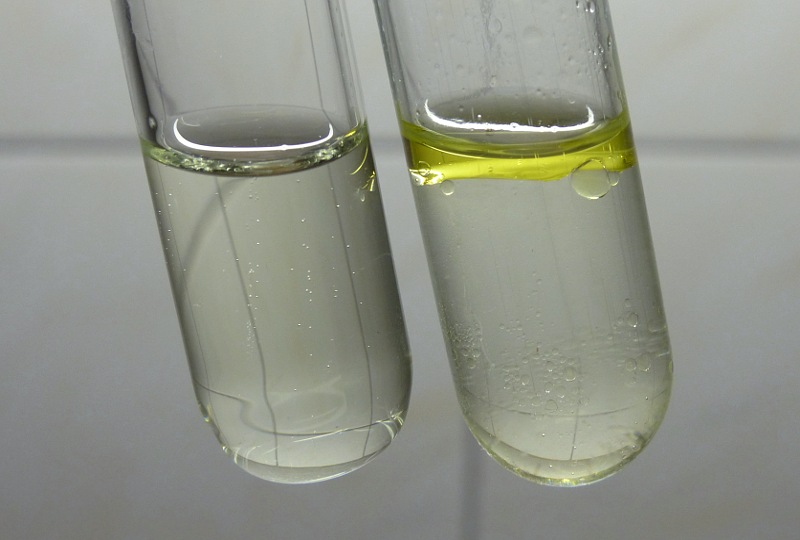


Formation of nitrosamine
A well-known method of conserving meat and fish is curing it with sodium nitrite and sodium chloride. A mix of these two salts is used for that purpose, usually a few percent of sodium nitrite (e.g. 3%) and the remaining part being sodium chloride. Meat, treated with such so-called curing salt, is protected against botulism, a very dangerous bacterial contamination of meat, and such meat also keeps a nice red color instead of turning grey in contact with air.
Unfortunately, the curing of meat with small amounts of sodium nitrite has an unpleasant side effect.
Meat and especially fish contain small amounts of some amines, most notable methyl amine, dimethyl amine and trimethyl amine. These amines contribute to the taste and smell of meat and fish. If they are present in too large quantities (if the meat or fish becomes old and stale), then the fish or meat obtains a bad smell. These amines are not toxic in the small amounts in which they usually are found in meat and fish. The dimethyl amine, however, is problematic when combined with nitrite at moderately low pH. When this happens, then a so-called nitrosamine is formed, a compound with an =N-N=O group. A secondary amine, with groups R and R' attached to the nitrogen atom reacts with nitrous acid as follows:
R'RNH + HO-N=O → R'RN-N=O + H-OH
The compound R'RN-N=O is called a nitrosamine. E.g. the secondary amine (CH3)2NH gives dimethylnitrosamine, (CH3)2N-N=O with nitrous acid. This reaction occurs in the stomach, where pH is quite low (can be as low as 2) and where the nitrite ion is converted to nitrous acid.
The simplest nitrosamines are pale yellow liquids. Dimethylnitrosamine is freely soluble in water, diethylnitrosamine is sparingly soluble in water, higher nitrosamines are nearly insoluble in water.
The formation of nitrosamines can be easily demonstrated in a test tube. Especially the diethyl-variant is easily isolated. Just prepare a concentrated mix of the amine with some acid, such that the liquid is slightly acidic and contains a fairly large concentration of the substituted ammonium salt, and then add a concentrated solution of sodium nitrite and heat. The ethyl-solution becomes turbid and a yellow liquid separates from the aqueous layer and floats on top. The dimethylnitrosamine remains dissolved in the water, the diethylnitrosamine can be isolated.

The picture above shows the dimethylnitrosamine in solution at the left and the separated diethylnitrosamine at the right.
The exact experimental procedure for making the yellow diethylnitrosamine is simple:
- Take 0.5 ml of diethylamine and add 1 ml of water.
- Take 0.5 grams of sodium nitrite and dissolve in a small amount of water.
- Add the solution of sodium nitrite to the solution of diethylamine
- Add a small amount of dilute (e.g. 2M) sulphuric acid. When this is done, no bubbles of NO and NO2 are produced.
- Swirl the test tube and gently heat the liquid. The liquid soon becomes turbid and within a few minutes a nice and clear yellow layer is formed on top of the aqueous layer.
The procedure for making the dimethylnitrosamine is as follows:
- Take 0.5 grams of dimethylammonium chloride and dissolve in a small amount of water.
- Take 0.5 grams of sodium nitrite and dissolve in a small amount of water.
- Add the solution of sodium nitrite to the solution of dimethylammonium chloride.
- Add a small amount of dilute (e.g. 2M) sulphuric acid. When this is done, only a marginal amount of bubbles of NO and NO2 are produced (the picture shows some of these bubbles).
- Swirl the test tube and gently heat the liquid. During heating, slightly more bubbles are produced and the color shifts from pale blue (color of nitrous acid in aqueous solution) to pale yellow (color of the nitrosamine).
The formation of nitrosamines is facile and also occurs in meat, consumed by humans, both inside the body, and sometimes also during preparation of the meat (e.g. during cooking or baking). Nitrosamines have moderate acute toxicity, but they are potent carcinogens and that is the reason why formation of them in meat and fish is such a bad thing.
When you perform this experiment, then use very good ventilation or work outside. You do not want to inhale vapor of the nitrosamines or small droplets of solution, containing the nitrosamines. Disposal is easy. Add so much tap water to the test tube with diethylnitrosamine, such that it is nearly full, stopper it and then turn it upside down a few times. The diethylnitrosamine dissolves in the water completely and then can be flushed down the drain with lots of water. The same can be done with the solution which contains dimethylnitrosamine. These compounds are quickly destroyed in the sewer system and do not bioaccumulate.